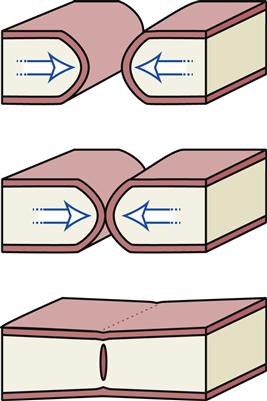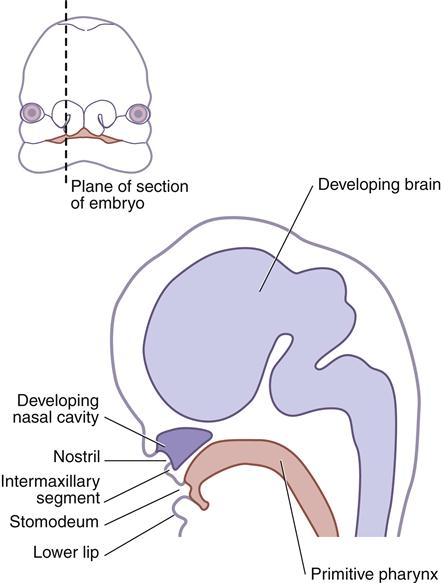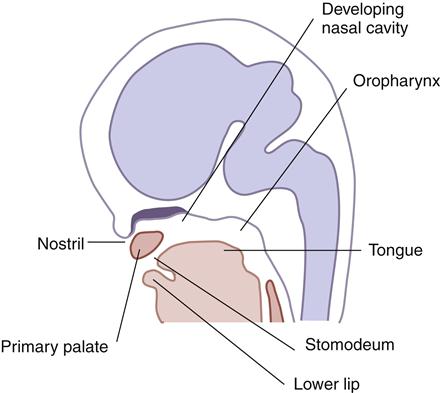Development of Orofacial Structures
Learning Objectives
New Key Terms
Ankyloglossia (ang-ke-lo-gloss-ee-ah)
Cleft palate (kleft pal-it), uvula
Copula (kop-u-lah)
Epiglottic swelling (ep-ee-glot-ik)
Lateral lingual swellings (ling-gwal)
Palatal shelves (pal-ah-tal)
Palate (pal-it): primary, secondary
Tuberculum impar (too-ber-ku-lum im-par)
Orofacial Development
The orofacial structures discussed in this chapter develop during the fourth week to the twelfth week of prenatal development, spanning the later embryonic period and early fetal period. This chapter continues with embryonic development, starting from where the sequence left off with the development of the stomodeum, face and neck in Chapter 4 (see Figure 4-1 and Box 4-1). It discusses the development of the associated oral structures: palate, nasal septum, nasal cavity, and tongue, with tooth development discussed in Chapter 6. However, the development of other oral structures, such as the jaws, temporomandibular joint, and salivary glands, is discussed with their associated histology in later chapters.
Dental professionals must have an understanding about the development of the oral structures to relate their underlying structural relationships to any developmental disturbances that may be present.
Palatal Development
The formation of the palate, initially in the embryo and later in the fetus, takes place over several weeks of prenatal development (Table 5-1). The formation of the palate starts during the fifth week of prenatal development, within the embryonic period. The palate at this time is formed from two separate embryonic structures: primary palate and secondary palate. The palate is then completed later during the twelfth week, within the fetal period. Thus, the palate is developed in three consecutive stages: formation of the primary palate, formation of the secondary palate, and completion of the final palate.
TABLE 5-1
| TIME PERIOD | PALATAL PORTIONS INVOLVED |
| Fifth to sixth week | Primary palate: intermaxillary segment from fused medial nasal processes |
| Sixth to twelfth week | Secondary palate: fused palatal shelves from maxillary processes |
| Twelfth week | Final palate: fusion of all three processes |
The completion of the final palate involves the fusion of swellings or tissue from different surfaces of the embryo to meet and join, similar to that of the fusion of the neural tube (Figure 5-1, see Figure 3-10). In contrast, most of the other structures of the orofacial region develop by facial fusion, the joining of swellings or tissue on the same surface of the embryo, which leads to the elimination of furrows between facial tissue (see Figure 4-4).
Primary Palate Formation
During the fifth week of prenatal development, still within the embryonic period, the intermaxillary segment forms (Figure 5-2). The intermaxillary segment arises as a result of fusion of the two medial nasal processes within the embryo (see Figure 4-7). The intermaxillary segment is an internal wedge-shaped mass that extends inferiorly and deep to the nasal pits on the inside of the stomodeum. It develops into the floor of the nasal cavity and the nasal septum.
The intermaxillary segment also gives rise to the primary palate (or primitive palate). At this time, the primary palate serves only as a partial separation between the developing oral cavity proper and nasal cavity (Figure 5-3). In the future, the primary palate will form the premaxillary part of the maxilla, which is the anterior one third of the final palate. This small part of the hard palate is anterior to the incisive foramen and will contain certain maxillary teeth (incisors) (see Figure 2-12). The formation of the primary palate completes the first stage of palate development.
Secondary Palate Formation
During the sixth week of prenatal development, within the embryonic period, the bilateral maxillary processes give rise to two palatal shelves (or lateral palatine processes) (Figures 5-4 and 5-5). These shelves grow inferiorly and deep on the inside of the stomodeum in a vertical direction, along both sides of the developing tongue. The tongue is forming on the floor of the pharynx at this time, and, as it grows, it initially fills the common nasal and oral cavity (discussed later).
Stay updated, free dental videos. Join our Telegram channel

VIDEdental - Online dental courses





